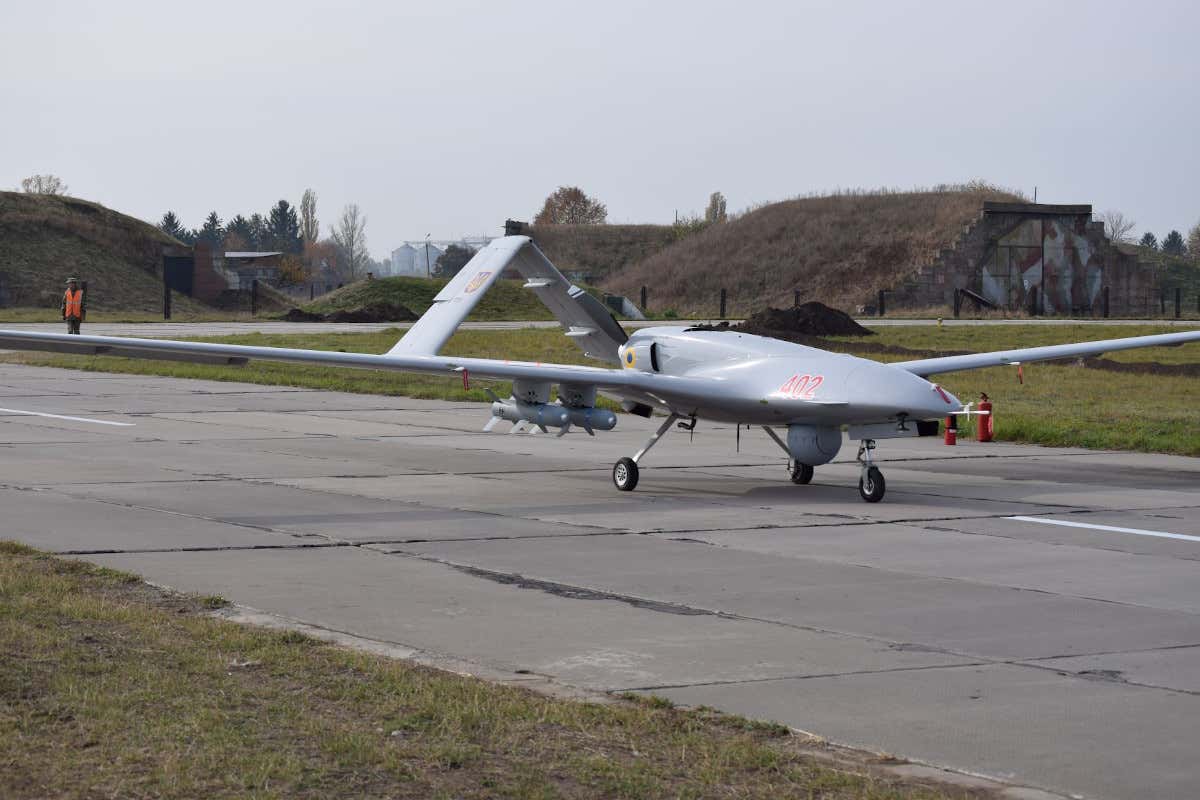Ukrainian armed forces appear to be using a futuristic counter-drone rifle supplied by Lithuania that can emit electromagnetic waves at drones to bring them down.
The ongoing Russia-Ukraine war has seen some of the best weaponry being fielded from either side, especially from Ukraine which has been receiving arms from its international partners like the US, Turkey, UK, Lithuania, and Poland, among others.
Among these, the Turkish-made Bayraktar TB2s have risen to an unprecedented level of prominence as it has now become a symbol of Ukrainian resistance against Russian forces.
The world has witnessed the impressive deployment by Ukraine of its fleet of drones against Russian armed forces managing to keep the Ukrainian airspace contested for more than a month since the onset of war.

While at the same time Ukraine also possesses some of the latest state-of-the-art counter-drone technologies such as the SkyWiper (EDM4S) Electronic Drone Mitigation System anti-drone rifles produced by a Lithuanian company known as NT Service.
A photo is doing the rounds on social media showing the Commander-in-Chief of the Armed Forces of Ukraine Valeriy Zaluzhnyi with Lithuanian EDM4S anti-drone rifles.
These guns are designed to neutralize small and medium-sized Unmanned Aerial Vehicles (UAVs) and are capable of identifying and actively disrupting UAV guidance, tracking and navigation systems.
????⚡️Commander-in-Chief of the Armed Forces of Ukraine Valeriy Zaluzhnyi with Lithuanian EDM-4S Skysweeper anti-drone rifles used to counter small and medium-sized drones. pic.twitter.com/idBibv2vp4
— Ukraine War Report (@UkrWarReport) April 11, 2022
The small size of drones and their ability to move quickly makes it very difficult for kinetic weapons like nets, bullets, and missiles to detect, target, and attack them and therefore in recent years, weaponized drones are emerging as game-changers on the battlefield, such as in the 2020 Nagorno-Karabakh war and the Libyan civil war
Keeping with the trend of increasing threats from UAVs, the Ukrainian army decided to order hand-held electronic warfare systems to counter UAVs.
The contract with NT Service was signed in 2020 through the NATO Support and Supply Agency for the supply of 37 SkyWiper EDM4S systems. Under the terms of the agreement, the manufacturer has to customize the system to fulfill the requirements of the Ukrainian Armed Forces. The version of the system sold to Ukraine is designated as EDM4S-UA.

According to media reports, the Ukrainian military started fielding the SkyWiper guns in 2021 against the Russian separatist forces in frontline areas of Donbas.
The operator is supposed to point the EDM4S jammer at a drone and then pull the trigger following which an electro-magnetic pulse will be sent in the direction of the UAV which will disrupt the communication between the drone and its operators.
All modules of the system are mounted on a robust frame of light aluminum construction that resembles the appearance of a rifle.
The gun is fitted with 4 directional antennas which can be expanded to 6 antennas. Two antennas for the 2.4 GHz and 5.8 GHz frequency bands with a power of 10 W each, and one antenna for GPS interference for the 1.5 GHz band with a power of 10 W, while another one to interfere with the GLONASS system for the 1.5 GHz band with a power of 10 W. A system adapted to work with other frequencies can be supplied on request.
The SkyWiper jammer is meant to be used by a single operator. It weighs 5.5 kg and has a range of 3-5 km.
According to claims by NT Service, the EDM4S jammer uses a monitoring system connected to aerial detectors that alert the operator on duty about the drone intrusion and location.
Most Russian military drones come under small and medium-size categories which include Granat 1, Granat 2, Eleron-3, Zala models, Orlan-10, Takhion, and Zastava. These are small enough to disappear once they reach a typical operating altitude of a mile to a mile and a half.
Therefore, the EDM4S jammer system designed to engage small and medium-sized UAVs should be appropriate to counter the Russian drone threat.
However, so far there is no documented evidence of EDM4S jammers or any other electronic measures having brought down a Russian drone in the ongoing Ukraine war.
According to Samuel Bendett, a researcher with the Center for a New American Security the standard Russian concept of operations involves the use of UAVs as airborne “eyes and ears”: observing surrounding territory, relaying data between commanders and deployed forces, and identifying and tracking targets that can then be destroyed by anything from an infantry fire squad to a tank to an artillery brigade to a warship.
However, the initial Russian military assaults in Ukraine lacked the type of situational awareness that such drones are supposed to provide, noted BennettdefensI.
He suggests that one of the reasons behind this might be the Ukrainian Air Defenses and ‘Electronic Warfare Networks’ which may be interfering with Russian efforts to put its drones to use.
Startstreak hitting Orion combat drone that was shot down two days ago over Kherson. I must say British defence equipment made a difference in this war and Boris visiting Ukraine is definitely one positive thing i can associate with him. ?? https://t.co/brln7zSmu1 pic.twitter.com/PWKEBhdkJK
— ST (@aviation07101) April 10, 2022
Recently, Ukraine forces reportedly shot down Russia’s newest Orion medium altitude and long-range (MALE) tactical UAV system using the British-made Starstreak missile which is the latest in the series of Russian drones brought down by Ukrainian forces.
While photographic evidence so far available suggests that Russia has also managed to shoot down three of the Ukrainian Bayraktar TB2s.
- Written by Tanmay Kadam/EurAsian Times Desk
- Contact the author at etdesk@eurasiantimes.com
- Follow EurAsian Times on Google News




